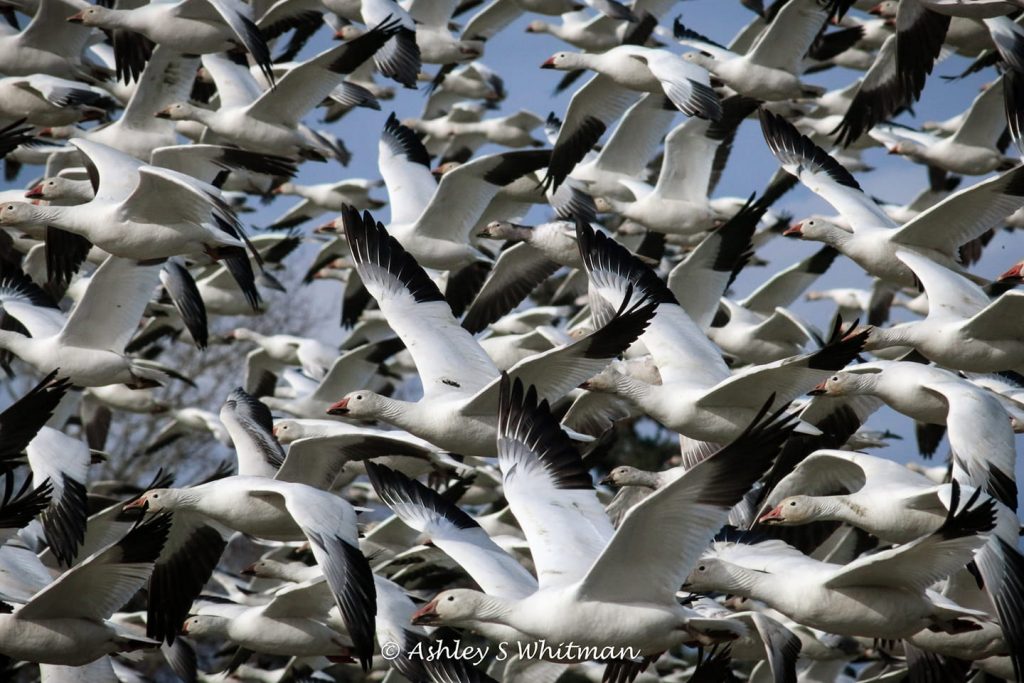If you’ve ever passed through the fertile flatlands of Western Skagit County during fall or winter, you’ve probably seen them at some point: enormous flocks of white birds with black wing tips, rising from fields to fill the sky in tightly-bunched formations, moving in tandem and making noise. They’re snow geese, specifically the white morph variety of the lesser snow goose. Slightly smaller than Canadian geese, these seasonal locals get here through an annual migratory flight of many miles, flying south for more survivable climes.
“It’s thrilling, looking and seeing groups of a thousand at a time, pouring overhead and calling the whole time,” says Libby Mills, a committee chair of the Skagit Audubon Society. “It’s just a beautiful thing.”

Long Ways from Home
The snow geese populating the Skagit Valley come from Wrangel Island, a piece of Russian-owned land about three-quarters the size of Hawaii’s Big Island.

Sitting in the Arctic Ocean north of the Siberian mainland, Wrangel is where the world’s last remaining woolly mammoths are thought to have died out about 4,000 years ago. Today, it is home to the breeding grounds of many bird species.
The journey from Wrangel to Skagit County is a journey of at least 2,000 miles, depending upon the aerial route. Snow geese can fly for hours without stopping, and Mills says that one bit of 1950s tracking research claimed some could fly continuously for up to 60 hours.
Departing from Siberia as good weather fades, the large flocks of geese begin arriving in Skagit from October into November.
Jeff Osmundson, Skagit Audubon Society president, says the Skagit Delta is a particularly good place for the geese to spend time because it’s among the first snow-free areas they encounter. The Fraser River Delta of British Columbia is another, and geese sometime move between the two areas, Mills adds.

Skagit in particular provides a nice mixture of agricultural lands and salt marshes to forage in: the geese initially feed on the field remnants of fall harvests, which include potatoes, carrots and corn. They often compete for these morsels with several species of swans and ducks, Mills says.
Come winter, grasses and winter wheat also sustain the geese, often to the chagrin of those who farm the latter crop. The birds often split up into sub-flocks during the winter, Mills says, feeding on fields near Stanwood in Snohomish County. In general, the geese like to circulate between fields and the salt water marshes of Skagit and Padilla Bays, where they face less danger of being picked off by predators like coyotes or, more common, bald eagles.
Mills says that eagles will often fly over flocks of snow geese to figure out what birds might be injured and unlikely to keep up with the flock. They then move in and pick them off. When you see a large flock suddenly scatter from a field, it’s often a response to an eagle.

Photo credit: David Lucas of Lucas Photographic
Like many types of water fowl with large populations, snow geese are also legally hunted by humans during specific seasons. In Whatcom and Skagit counties, snow geese can usually be hunted during sizeable periods of time from October through January.
Special hunts may also occur if oversize numbers of geese are damaging crops in specific fields, Osmundson says.
While neither Mills nor Osmundson could say how big the current snow goose population of Skagit has become, both say the flocks are growing. Annual migrations are estimated to be anywhere from 50,000 birds to north of 100,000.
The geese are so plentiful, in fact, that high survival rates are creating issues up north when the birds leave Skagit between late March and mid-April.
“Over the last 10 years, the population has grown to the extent that they’re starting to have some habitat damage on Wrangel Island,” Osmundson says. “They’re starting to exceed the carrying capacity up there.”
Where and How to See Them
During their stay here, snow geese can easily be glimpsed any time of day if you know where to look.
The Samish Flats is a great place to glimpse flocks of the fowl, as is Fir Island just south of Mount Vernon.
Mills recommends taking a bicycle ride to look for them when the weather is particularly nice in March.

Regardless of where you find snow geese, it’s important to respect private property and avoid trespassing just to get better views. It’s also obviously dangerous to get too close to the birds in a field if someone is actively attempting to hunt them.
If driving to a bird site, make sure you find a place to park safely with all four tires off the active roadway. Mills says a number of locations on Fir Island have wildlife pullouts, and other parking areas set aside by the Department of Fish and Wildlife also exist.
So, whether you’re looking for them or not, the next time you see a giant flock of snow geese take to the skies, consider taking a moment to watch and listen to nature in action. They’ve come an awful long ways, after all.
“The roar of wildlife,” Mills says, “is a pretty primal, wonderful thing for people who love wildlife.”





































